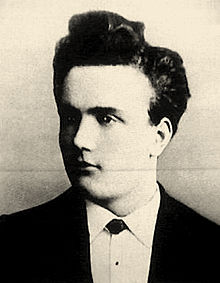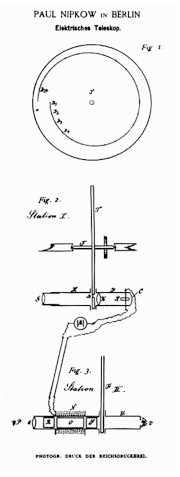Paul Gottlieb Nipkow
Paul Gottlieb Nipkow | |
|---|---|
 Nipkow in about 1884 | |
| Born | August 22, 1860 |
| Died | August 24, 1940 (aged 80) |
| Nationality | German |
| Occupation | Engineer |
| Engineering career | |
| Projects | Nipkow disk |
| Significant advance | television |
Paul Julius Gottlieb Nipkow (22 August 1860 – 24 August 1940) was a German technician and inventor.
Beginnings
Nipkow was a German born in Lauenburg (Lębork) in Pomerania. While at school in Neustadt (Wejherowo), West Prussia, Nipkow experimented in telephony and the transmission of moving pictures. After graduation, he went to Berlin in order to study science. He studied physiological optics with Hermann von Helmholtz, and electro-physics with Adolf Slaby.
Nipkow disk

While still a student he studied the Nipkow disk. Accounts of its invention state that he conceived the idea of using a spiral-perforated disk to divide a picture into a mosaic of points and lines while sitting alone at home with an oil lamp on Christmas Eve, 1883. It should be noted here that Alexander Bain had transmitted images telegraphically in the 1840s but the Nipkow disk improved the encoding process.
He applied to the imperial patent office in Berlin for a patent covering an electric telescope for the electric reproduction of illuminating objects, in the category "electric apparatuses". This was granted on 15 January 1885, retroactive to 6 January 1884. It is not known whether Nipkow ever attempted a practical realization of this disk but one may assume that he himself never constructed one. The patent lapsed after 15 years owing to lack of interest. Nipkow took up a position as a designer at an institute in Berlin-Buchloh and did not continue work on the broadcasting of pictures.
First TV systems
The first telecasts used an optical-mechanical picture scanning method, the method that Nipkow had helped create with his disk; he could claim some credit for the invention. Nipkow recounted his first sight of television at a Berlin radio show in 1928: "the televisions stood in dark cells. Hundreds stood and waited patiently for the moment at which they would see television for the first time. I waited among them, growing ever more nervous. Now for the first time I would see what I had devised 45 years ago. Finally I reached the front row; a dark cloth was pushed to the side, and I saw before me a flickering image, not easy to discern." The system demonstrated was from John Logie Baird's Baird Television Company. Baird was the first inventor to use Nipkow's disc successfully, creating the first television pictures in his laboratory in October 1925.
From 1937, when the infant BBC television service chose it above Baird's mechanical system, total electronic picture scanning, based on the work of Manfred von Ardenne and the iconoscope invented by Vladimir Zworykin, became increasingly prevalent and Nipkow's invention was no longer essential to further development of television.
Transmitter Paul Nipkow
Germany's first public television channel, started in Berlin in 1935, was named Fernsehsender Paul Nipkow after Paul Nipkow - the "spiritual father" of the core element of first generation television technology. He became honorary president of the "television council" of the "Imperial Broadcasting Chamber". Nipkow died in Berlin.
External links
- The Television System of Paul Nipkow
- "Will "camera-boxes" help catch Whitechapel Ripper?" A fictional piece about the use of Nipkow Disks in 1888 London, at Skeptic Friends Network.
